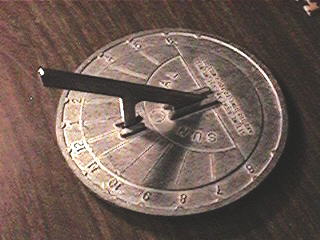 |
Numbering system most widely used by humans today is the decimal system, namely a base 10 number system. However, to measure time we use duodesimal system (base 12) and sexadesimal (base 60). This is because the method to divide the day derived from the number system used by the ancient Mediterranean civilizations. In about 1500 BC, ancient Egyptians use the number system based on 12, and they developed a system sundial shaped like the letter T is placed on the ground and divide their time between sunrise and sunset into 12 parts. Historians argue, the ancient Egyptians use number-based system will be based 12 months a year the number of cycles can also be based or will the large number of human finger joint (3 in each finger, excluding the thumb) which allows them count to 12 using the thumb .
Sundials next generation already represents more or less what we now call the "clock". While the division of the night into 12 parts, based on observations of ancient Egyptian astronomers will be the 12 stars in the sky at night.
By dividing one day and one night into each 12 hours, then with an indirect 24-hour concept is introduced. However, the long days and long nights are not the same, depending on the season (eg summer days longer than nights). Therefore, the distribution of hours in a day varies according to season. Time system is called the system time seasonal. In the years around 147-127 BC, a Greek astronomer named Hipparchus suggested that the number of hours in the day made it still as many as 24 hours, called the equinoctial time system. But the new system is now widely accepted by the discovery of mechanical clocks in Europe in the 14th century.
By dividing one day and one night into each 12 hours, then with an indirect 24-hour concept is introduced. However, the long days and long nights are not the same, depending on the season (eg summer days longer than nights). Therefore, the distribution of hours in a day varies according to season. Time system is called the system time seasonal. In the years around 147-127 BC, a Greek astronomer named Hipparchus suggested that the number of hours in the day made it still as many as 24 hours, called the equinoctial time system. But the new system is now widely accepted by the discovery of mechanical clocks in Europe in the 14th century.
 Eratosthenes (276-194 BC), a Greek astronomer divide a circle into 60 parts to create a system of geographic latitude. This technique is based on 60-based systems used by the Babylonians who settled in Mesopotamia, which if traced further derived from the system used by the Sumerian civilization around 2000 BC. It is not known with certainty why use a 60 based number system, but one conjecture to say for ease of calculation because the number 60 is the smallest number that can be divided up by 10, 12, 15, 20 and 30.
Eratosthenes (276-194 BC), a Greek astronomer divide a circle into 60 parts to create a system of geographic latitude. This technique is based on 60-based systems used by the Babylonians who settled in Mesopotamia, which if traced further derived from the system used by the Sumerian civilization around 2000 BC. It is not known with certainty why use a 60 based number system, but one conjecture to say for ease of calculation because the number 60 is the smallest number that can be divided up by 10, 12, 15, 20 and 30. A century later, Hipparchus introduced a system of longitude 360 degrees. And in about 130 AD, Claudius Ptolemy divides each degree into 60 parts. The first part is called the partes minutae primae which means the first minute, the second part is called partes minutae secundae or the second minute, and so on. Although there are 60 sections, which used only the first two parts of the course where the first part of a minute, and the second to second. While the remaining 58 are other parts to form a smaller unit of time than the second.
A century later, Hipparchus introduced a system of longitude 360 degrees. And in about 130 AD, Claudius Ptolemy divides each degree into 60 parts. The first part is called the partes minutae primae which means the first minute, the second part is called partes minutae secundae or the second minute, and so on. Although there are 60 sections, which used only the first two parts of the course where the first part of a minute, and the second to second. While the remaining 58 are other parts to form a smaller unit of time than the second.This time the system takes centuries to widespread use. Even at first clock that displays minutes made the first time in the 16th century. This time the system used today by our modern humans.
